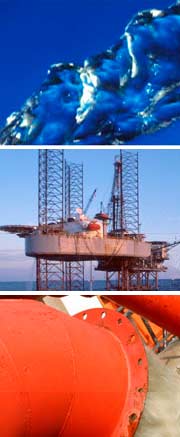  |

Bench Scale Study of Kengro Biosorb as a Potential Oil sorbent and Carrier of Biodegradatioin Microorganisms
 Presented by: Presented by:
Dr. Hamid Borazjani, Assistant Professor
Dr. Susan Diehl, Senior Research Assistant
Mississippi Forest Products Laboratory
Box 9820
Mississippi State, MS 39762-9820
September 27, 1993
OBJECTIVES; PROCEDURES; RESULTS & CONCLUSION
OBJECTIVES
The objectives of this laboratory study were as follows:
| 1. |
to determine the efficacy of Kengro Biosorb as a petroleum sorbent in soil highly contaminated with petroleum. |
| 2. |
to measure the TCLP (Toxicity Characteristic Leaching Potential) values of Kengro Biosorb saturated with petroleum oil. |
| 3. |
to evaluate the use of microorganism for bioremoval of petroleum oil from contaminated Kengro Biosorb. |
PROCEDURES
Efficacy Test
Twenty grams of clean, dry sandy soil was contaminated with 3 grams of petroleum oil (T-102) to a 15% oil concentration level. This soil was thoroughly mixed and homogenized. Two grams of Kengro Biosorb were mixed with the contaminated soil. After ten hours of dwell time, Kengro Biosorb was separated from soil by air fractionation. Soil and Kengro Biosorb were extracted and analyzed for total petroleum hydrocarbon (TPH) content.
TCLP test
Kengro Biosorb was contaminated with 75% total petroleum hydrocarbons. Five grams of contaminated sample and five grams of uncontaminated Kengro Biosorb were extracted for TCLP by EPA methods and analyzed for TPH content.
Bioremoval Test
Two grams of Kengro Biosorb contaminated with 75% petroleum oil were placed in erlenmeyer flasks along with 100 ml of sterile water plus either 25 ml of sterile water plus either 25 ml of JP bacteria culture in nutrient broth media (two flasks) or 25 ml nutrient broth only (two flasks). Flasks were placed on a rotary shaker for seven days. At the end of that time, Kengro Biosorb was filtered from the liquid media and all samples were tested for microbiological counts and TPH analysis.
RESULTS AND CONCLUSION
The results of the efficacy test are given in Table I. In comparison with starting soil, screened soil showed a 56% petroleum loss while Kengro Biosorb showed a 66% petroleum gain. The 10% difference is likely due to Kengro Biosorb absorbing organic other than petroleum oil from the soil.
Results of TCLP test are summarized in Table II. In comparison with the initial TPH concentration (750,000 ppm) , only 160 ppm or 0.02% TPH leached out of the Kengro Biosorb. This reinforces the excellent holding capacity of Kengro Biosorb as an oil sorbent.
Results of the bioremoval tests are summarized in Table III and Table IV. In comparison with the initial TPH concentration, both treatments significantly removed petroleum from Kengro Biosorb. The concentrations of TPH found in liquid media were minimal. Therefore most of the TPH removal can be attributed to biological degradation.
Bacterial populations in the nutrient broth only samples were significantly higher than our JP treatments. This could explain the slightly higher degradation rate of these samples.
These preliminary results indicate that Kengro Biosorb could be used as a excellent sorbent of oil and also as carrier of microorganisms for bioremediation of petroleum wastes. Indigenous microorganisms associated with Kengro Biosorb proved to be as effective a biodegrader as our JP isolate. Use of Kengro Biosorb for bioremdiation may provide a novel, inexpensive solution for such a complex problem.
to the top |
|





